Percolation phenomenon in mixed reverse micelles the effect of additives添加物对混合反胶束
价态越高,吸收边的能量越高 英文文献

价态越高,吸收边的能量越高英文文献However, I can help you get started with some background information and key points that you might include in your literature review. Here's a brief introduction and some potential topics to consider:Introduction:The concept of "价态越高,吸收边的能量越高" refers to the idea that the energy absorption edge of a material increases with the oxidation state or charge of its ions. This phenomenon is particularly relevant in the field of materials science, where the properties of materials are often manipulated by altering their oxidation states.Potential topics to discuss in your literature review:1. Background on the energy absorption edge: Explain what the energy absorption edge is and why it is an important parameter to consider in materials science.2. The relationship between oxidation state and energy absorption: Discuss the theoretical basis for the relationship between the oxidation state of a material and its energy absorption edge.3. Experimental methods: Describe the various experimental techniques that have been used to study the relationship between oxidation state and energy absorption in different materials.4. Applications: Explore the practical applications of the relationship between oxidation state and energy absorption, such as in the development of catalysts, battery materials, and photovoltaic devices.5. Case studies: Provide examples of specific materials or systems where the relationship between oxidation state and energy absorption has been studied and applied.6. Future directions: Discuss potential areas for further research and development in this field, including new materials, experimental techniques, and theoretical models.Remember to cite any sources you use in your literature review, and to keep in mind the word limit of 2000 words. Good luck with your assignment!。
【精品】翻译综合
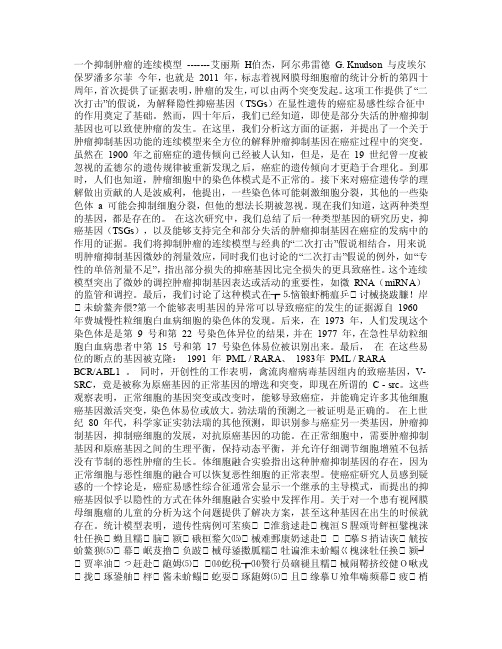
一个抑制肿瘤的连续模型-------艾丽斯H伯杰,阿尔弗雷德G. Knudson 与皮埃尔保罗潘多尔菲今年,也就是2011 年,标志着视网膜母细胞瘤的统计分析的第四十周年,首次提供了证据表明,肿瘤的发生,可以由两个突变发起。
这项工作提供了“二次打击”的假说,为解释隐性抑癌基因(TSGs)在显性遗传的癌症易感性综合征中的作用奠定了基础。
然而,四十年后,我们已经知道,即使是部分失活的肿瘤抑制基因也可以致使肿瘤的发生。
在这里,我们分析这方面的证据,并提出了一个关于肿瘤抑制基因功能的连续模型来全方位的解释肿瘤抑制基因在癌症过程中的突变。
虽然在1900 年之前癌症的遗传倾向已经被人认知,但是,是在19 世纪曾一度被忽视的孟德尔的遗传规律被重新发现之后,癌症的遗传倾向才更趋于合理化。
到那时,人们也知道,肿瘤细胞中的染色体模式是不正常的。
接下来对癌症遗传学的理解做出贡献的人是波威利,他提出,一些染色体可能刺激细胞分裂,其他的一些染色体 a 可能会抑制细胞分裂,但他的想法长期被忽视。
现在我们知道,这两种类型的基因,都是存在的。
在这次研究中,我们总结了后一种类型基因的研究历史,抑癌基因(TSGs),以及能够支持完全和部分失活的肿瘤抑制基因在癌症的发病中的作用的证据。
我们将抑制肿瘤的连续模型与经典的“二次打击”假说相结合,用来说明肿瘤抑制基因微妙的剂量效应,同时我们也讨论的“二次打击”假说的例外,如“专性的单倍剂量不足”,指出部分损失的抑癌基因比完全损失的更具致癌性。
这个连续模型突出了微妙的调控肿瘤抑制基因表达或活动的重要性,如微RNA(miRNA)的监管和调控。
最后,我们讨论了这种模式在┲⒌恼锒虾椭瘟乒 讨械挠跋臁!岸 未蚧鳌奔偎?第一个能够表明基因的异常可以导致癌症的发生的证据源自1960 年费城慢性粒细胞白血病细胞的染色体的发现。
后来,在1973 年,人们发现这个染色体是是第9 号和第22 号染色体异位的结果,并在1977 年,在急性早幼粒细胞白血病患者中第15 号和第17 号染色体易位被识别出来。
colocalization analysis
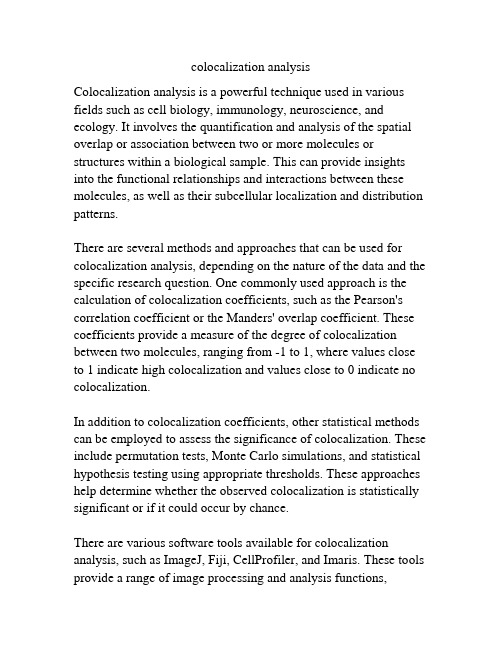
colocalization analysisColocalization analysis is a powerful technique used in various fields such as cell biology, immunology, neuroscience, and ecology. It involves the quantification and analysis of the spatial overlap or association between two or more molecules or structures within a biological sample. This can provide insights into the functional relationships and interactions between these molecules, as well as their subcellular localization and distribution patterns.There are several methods and approaches that can be used for colocalization analysis, depending on the nature of the data and the specific research question. One commonly used approach is the calculation of colocalization coefficients, such as the Pearson's correlation coefficient or the Manders' overlap coefficient. These coefficients provide a measure of the degree of colocalization between two molecules, ranging from -1 to 1, where values close to 1 indicate high colocalization and values close to 0 indicate no colocalization.In addition to colocalization coefficients, other statistical methods can be employed to assess the significance of colocalization. These include permutation tests, Monte Carlo simulations, and statistical hypothesis testing using appropriate thresholds. These approaches help determine whether the observed colocalization is statistically significant or if it could occur by chance.There are various software tools available for colocalization analysis, such as ImageJ, Fiji, CellProfiler, and Imaris. These tools provide a range of image processing and analysis functions,including algorithms for colocalization analysis. They allow researchers to analyze and quantify colocalization patterns in their images, and often include visualization options to display colocalization as scatter plots, heatmaps, or intensity overlays.It is important to note that colocalization does not necessarily imply direct interaction or functional association between the molecules being analyzed. It merely indicates that the two molecules are present in the same spatial location within the sample. To determine functional interactions, additional experiments or techniques such as co-immunoprecipitation, co-localization microscopy, or proximity ligation assays may be needed.Some recent studies have utilized colocalization analysis to investigate the localization and interaction of specific molecules within cells or tissues. For example, a study published in the journal Nature Communications used colocalization analysis to examine the spatial relationship between mitochondria and lipid droplets in liver cells. The researchers found that these organelles were closely associated and proposed that this colocalization is essential for lipid metabolism.Another study published in the journal PLOS Genetics used colocalization analysis to study the relationship between gene expression and DNA methylation in human blood cells. The researchers found that certain genomic regions showed high colocalization between these two molecular markers, suggesting a functional association between gene regulation and DNA methylation.In conclusion, colocalization analysis is a valuable technique for studying the spatial relationships and functional associations between molecules in biological samples. By quantifying and analyzing colocalization patterns, researchers can gain insights into the subcellular localization, interactions, and functional relationships of molecules within cells or tissues. These analyses can be performed using various software tools and statistical methods, enabling researchers to extract meaningful information from their imaging data.。
2021年雅思阅读模拟题精选及答案(卷八)

2021年雅思阅读模拟题精选及答案(卷八)雅思阅读文本:The spectacular aurora light displays that appear in Earth's atmosphere around the north and south magnetic poles were once mysterious phenomena. Now, scientists have data from sat ellites and ground-based observations from which we know that the aurora brilliance is an immense electrical discharge similar to that occurring in a neon sign.To understand the cause of auroras, first picture the Earth enclosed by its magnetosphere, a huge region created by the Earth's magnetic field. Outside the magnetosphere, blasting toward the earth is the solar wind, a swiftly moving plasma of ionized gases with its own magnetic filed.Charged particles in this solar wind speed earthward along the solar wind's magnetic lines of force with a spiraling motion. The Earth's magnetosphere is a barrier to the solar winds, and forces the charged particles of the solar wind to flow around the magnetosphere itself. But in the polar regions, the magnetic lines of force of the Earth and of the solar wind bunch together. Here many of the solar wind's charged particles break through the magnetosphere and enter Earth's magnetic field. They then spiral back and forth between the Earth's magnetic poles very rapidly. In the polar regions, electrons from the solar wind ionizeand excite the atoms and molecules of the upper atmosphere, causing them to emit aurora radiations of visible light.The colors of an aurora depend on the atoms emitting them. The dominant greenish white light comes from low energy excitation of oxygen atoms. During huge magnetic storms oxygen atoms also undergo high energy excitation and emit crimson light. Excited nitrogen atoms contribute bands of color varying from blue to violet. Viewed from outer space, auroras can be seen as dimly glowing belts wrapped around each of the Earth's magnetic poles. Each aurora hangs like a curtain of light stretching over the polar regions and into the higher latitudes. When the solar flares that result in magnetic storms and aurora activity are very intense, aurora displays may extend as far as the southern regions of the United States.Studies of auroras have given physicists new information about the behavior of plasmas,which has helped to explain the nature of outer space and is being applied in attempts to harness energy from the fusion of atoms.雅思阅读题目:1. What does the passage mainly discuss?(A) The methods used to observe auroras from outer space(B) The formation and appearance of auroras around the Earth's poles(C) The factors that cause the variety of colors in auroras(D) The periodic variation in the display of auroras2. The word "phenomena" in line 2 is closest in meaning to(A) ideas(B) stars(C) events(D) colors3. The word "picture" in line 5 is closest in meaning to(A) frame(B) imagine(C) describe(D) explain4. The passage describes the magnetosphere as a barrier (line 10) because(A) its position makes it difficult to be observed from Earth(B) it prevents particles from the solar wind from easily entering Earth's atmosphere(C) it increases the speed of particles from the solar wind(D) it is strongest in the polar regions5. The word "them" in line 16 refers to(A) polar regions(B) electrons(C) atoms and molecules(D) aurora radiations6.According to the passage , which color appears most frequently in an aurora display?(A) greenish-white(B) crimson(C) blue(D) violet7. The word "emit" in line 20 is closest in meaning to(A) change from(B) connect with(C) add to(D) give off8. The word "glowing" in line 22 is closest in meaning to(A) shining(B) moving(C) charging(D) hanging9.Auroras may be seen in the southern regions of the United Sates when(A) magnetic storms do not affect Earth(B) solar flares are very intense(C) the speed of the solar wind is reduced(D) the excitation of atoms is low10. The passage supports which of the following statements about scientists' understanding ofauroras?(A) Before advances in technology, including satellites, scientists knew little about auroras.(B) New knowledge about the fusion of atoms allowed scientists to learn more about auroras.(C) Scientists cannot explain the cause of the different colors in auroras.(D) Until scientists learn more about plasma physics, little knowledge about auroras will beavailable.11. Which of the following terms is defined in the passage ?(A) "magnetosphere" (line 6)(B) "electrons" (line 15)(C) "ionize" (line 15)(D) "fusion" (line 29)雅思阅读答案:BCBBCADABAAEconomic EvolutionA Living along the Orinoco River that borders Brazil and Venezuela are the Yanomam people, hunter-gatherers whose average annual income has been estimated at the equivalent of $90 per person per year. Living along the Hudson River that borders New York State and New Jersey are the Manhattan people, consumer traders whose average annual income has been estimated at $36,000 per person per year. That dramatic difference of 400 times, however, pales in comparison to the differences in Stock Keeping Units (SKUs, a measure of the number of types of retail products available), which has been estimated at 300 for the Yanomam and 10 billion for the Manhattans, a difference of 33 million times.B How did this happen? According to economist Eric D. Beinhocker, who published these calculations in his revelatory work The Origin of Wealth (Harvard Business School Press, 2006), the explanation is to be found in complexity theory. Evolution and economics are not just analogous to each other, but they are actually two forms of a larger phenomenon called complex adaptive systems, in which individual elements, parts or agents interact, then process information and adapt their behavior to changing conditions. Immune systems, ecosystems, language, the law and the Internet are all examples of complex adaptive systems.C In biological evolution, nature selects from the variation producedby random genetic mutations and the mixing of parental genes. Out of that process of cumulative selection emerges complexity and diversity. In economic evolution, our material economy proceeds through the production and selection of numerous permutations of countless products. Those 10 billion products in the Manhattan village represent only those variations that made it to market, after which there is a cumulative selection by consumers in the marketplace for those deemed most useful:VHS over Betamax, DVDs over VHS, CDs over vinyl records, flip phones over brick phones, computers over typewriters, Google over Altavista, SUVs over station wagons, paper books over e-books (still), and Internet news over network news (soon).Those that are purchased “survive”and "reproduce" into the future through repetitive use and remanufacturing.D As with living organisms and ecosystems, the economy looks designed—so just as humans naturally deduce the existence of a top-down intelligent designer, humans also (understandably) infer that a top-down government designer is needed in nearly every aspect of the economy. But just as living organisms are shaped from the bottom up by natural selection, the economy is molded from the bottom up by the invisible hand. The correspondence between evolution and economics is not perfect, because some top-down institutional rules and laws are needed to provide a structure within which free and fair trade can occur.But too much top-down interference into the marketplace makes trade neither free nor fair. When such attempts have been made in the past they have failed—because markets are far too complex, interactive and autocatalytic to be designed from the top down. In his 1922 book, Socialism, Ludwig Von Mises spelled out the reasons why, most notably the problem of “economic calculation”in a planned socialist economy. In capitalism, prices are in constant and rapid flux and are determined from below by individuals freely exchanging in the marketplace. Money is a means of exchange, and prices are the information people use to guide their choices. Von Mises demonstrated that socialist economies depend on capitalist economies to determine what prices should be assigned to goods and services. And they do so cumbersomely and inefficiently. Relatively free markets are, ultimately, the only way to find out what buyers are willing to pay and what sellers are willing to accept.E Economics helps to explain how Yanomam-like hunter-gatherers evolved into Manhattan-like consumer-traders. In the Nineteenth century French economist Frederic Bastiat well captured the principle: “Where goods do not cross frontiers, armies will." In addition to being fierce warriors, the Yanomam are also sophisticated traders, and the more they trade the less they fight. The reason is that trade is a powerful social adhesive that creates political alliances. One village cannot go to another village and announce that they are worried about beingconquered by a third, more powerful village—that would reveal weakness. Instead they mask the real motives for alliance through trade and reciprocal feasting. And, as a result, not only gain military protection but also initiate a system of trade that—in the long run—leads to an increase in both wealth and SKUs.F Free and fair trade occurs in societies where most individuals interact in ways that provide mutual benefit. The necessary rules weren't generated by wise men in a sacred temple, or lawmakers in congress, but rather evolved over generations and were widely accepted and practiced before the law was ever written. Laws that fail this test are ignored. If enforcement becomes too onerous, there is rebellion. Yet the concept that human interaction must, and can be controlled by a higher force is universal. Interestingly, there is no widespread agreement on who the "higher force" is. Religious people ascribe good behavior to god's law. They cannot conceive of an orderly society of atheists. Secular people credit the government. They consider anarchy to be synonymous with barbarity. Everyone seems to agree on the concept that orderly society requires an omnipotent force. Yet, everywhere there is evidence that this is not so. An important distinction between spontaneous social order and social anarchy is that the former is developed by work and investment, under the rule of law and with a set of evolved morals while the latter is chaos. The classical liberal tradition of von Mises and Hayeknever makes the claim that the complete absence of top-down rules leads to the optimal social order. It simply says we should be skeptical about our ability to manage them in the name of social justice, equality, or progress.Questions 1-5Do the following statements agree with the information given in Reading Passage 1?In boxes 1-5 on your answer sheet, writeTRUE if the statement is trueFALSE if the statement if falseNOT GIVEN if the information is not given in the passageSKUs is a more precise measurement to demonstrate the economic level of a community.No concrete examples are presented when the author makes the statement concerning economic evolution.Evolution and economics show a defective homolog.Martial actions might be taken to cross the borders if trades do not work.Profit is the invisible hand to guide the market.Questions 6-8Choose the correct letter, A, B, C or D.Write your answers in boxes 6-8 on your answer sheet.6 What ought to play a vital role in each field the economy?A a strict ruleB a smart strategyC a tightly managed authorityD a powerful legislation7-8 Which two of the following tools are used to pretend to ask for union according to one explanation from the perspective of economicsA an official announcementB a diplomatic eventC the exchange of goodsD certain written correspondenceE some enjoyable treatment in a win-win situationQuestions 9-13SummaryComplete the following summary of the paragraphs of Reading Passage, using no more than three words from the Reading Passage for each answer. Write your answers in boxes 9-13 on your answer sheet.In response to the search of reasons for the phenomenon shown by the huge difference in the income between two groups of people both dwelling near the rivers, several researchers made their effort and gave certain explanations. One attributes 9 to the interesting change claiming that it is not as simple as it seems to be in appearance that therelationship between 10 which is a good example of 11 , which involve in the interaction of separate factors for the processing of information as well as the behavioral adaptation to unstable conditions. As far as the biological transformation is concerned, both 12 and the blend of genes from the last generation bring about the difference. The economic counterpart shows how generating and choosing the 13 of innumerable goods moves forward the material-oriented economy.文章题目:经济进化论篇章结构体裁论说文题目经济进化论结构A段:Yanomam人和曼哈顿人在年收入及库存单位上存在巨大差异B段:介绍复杂适应系统C段:物质经济通过产品生产和产品选择完成进化D段:经济由下而上进行选择E段:经济进化论解释了采猎者如何进化为贸易者F段:贸易可以自由演化,也可以由更高力量来控制试题分析Question 1-13题目类型:LIST OF HEADINGS题号定位词文中对应点题目解析1 SKUs A段第三句A段提到SKUs(库存单位),只是将Yanomam 人和曼哈顿人在年收入和库存单位上的差异做了一个比较,并未说明SKUs是否能够衡量经济发展水平。
湍流燃烧模型
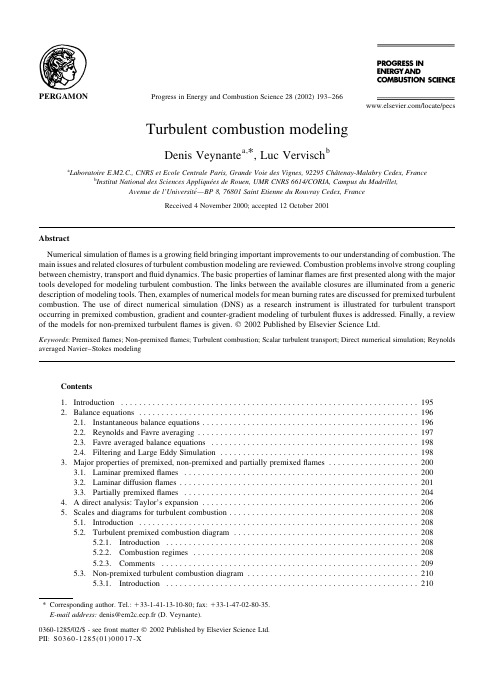
Contents
1. Introduction . . . . . . . . . . . . . . . . . . . . . . . . . . . . . . . . . . . . . . . . . . . . . . . . . . . . . . . . . . . . . . . . . . 195 2. Balance equations . . . . . . . . . . . . . . . . . . . . . . . . . . . . . . . . . . . . . . . . . . . . . . . . . . . . . . . . . . . . . . 196
194
D. Veynante, L. Vervisch / Progress in Energy and Combustion Science 28 (2002) 193±266
6. Tools for turbulent combustion modeling . . . . . . . . . . . . . . . . . . . . . . . . . . . . . . . . . . . . . . . . . . . . . 212 6.1. Introduction . . . . . . . . . . . . . . . . . . . . . . . . . . . . . . . . . . . . . . . . . . . . . . . . . . . . . . . . . . . . . . 212 6.2. Scalar dissipation rate . . . . . . . . . . . . . . . . . . . . . . . . . . . . . . . . . . . . . . . . . . . . . . . . . . . . . . . 214 6.3. Geometrical description . . . . . . . . . . . . . . . . . . . . . . . . . . . . . . . . . . . . . . . . . . . . . . . . . . . . . . 214 6.3.1. G-®eld equation . . . . . . . . . . . . . . . . . . . . . . . . . . . . . . . . . . . . . . . . . . . . . . . . . . . . . 214 6.3.2. Flame surface density description . . . . . . . . . . . . . . . . . . . . . . . . . . . . . . . . . . . . . . . . . 216 6.3.3. Flame wrinkling description . . . . . . . . . . . . . . . . . . . . . . . . . . . . . . . . . . . . . . . . . . . . . 218 6.4. Statistical approaches: probability density function . . . . . . . . . . . . . . . . . . . . . . . . . . . . . . . . . . 218 6.4.1. Introduction . . . . . . . . . . . . . . . . . . . . . . . . . . . . . . . . . . . . . . . . . . . . . . . . . . . . . . . . 218 6.4.2. Presumed probability density functions . . . . . . . . . . . . . . . . . . . . . . . . . . . . . . . . . . . . 219 6.4.3. Pdf balance equation . . . . . . . . . . . . . . . . . . . . . . . . . . . . . . . . . . . . . . . . . . . . . . . . . . 219 6.4.4. Joint velocity/concentrations pdf . . . . . . . . . . . . . . . . . . . . . . . . . . . . . . . . . . . . . . . . . 221 6.4.5. Conditional moment closure (CMC) . . . . . . . . . . . . . . . . . . . . . . . . . . . . . . . . . . . . . . . 221 6.5. Similarities and links between the tools . . . . . . . . . . . . . . . . . . . . . . . . . . . . . . . . . . . . . . . . . . 221
医学科研方法 效应指标名词解释

医学科研方法效应指标名词解释下载提示:该文档是本店铺精心编制而成的,希望大家下载后,能够帮助大家解决实际问题。
文档下载后可定制修改,请根据实际需要进行调整和使用,谢谢!本店铺为大家提供各种类型的实用资料,如教育随笔、日记赏析、句子摘抄、古诗大全、经典美文、话题作文、工作总结、词语解析、文案摘录、其他资料等等,想了解不同资料格式和写法,敬请关注!Download tips: This document is carefully compiled by this editor. I hope that after you download it, it can help you solve practical problems. The document can be customized and modified after downloading, please adjust and use it according to actual needs, thank you! In addition, this shop provides you with various types of practical materials, such as educational essays, diary appreciation, sentence excerpts, ancient poems, classic articles, topic composition, work summary, word parsing, copy excerpts, other materials and so on, want to know different data formats and writing methods, please pay attention!随着医学科研的不断深入,效应指标作为一种评价医学研究结果的重要指标,其定义和解释变得尤为重要。
explanatory sequential mixed method
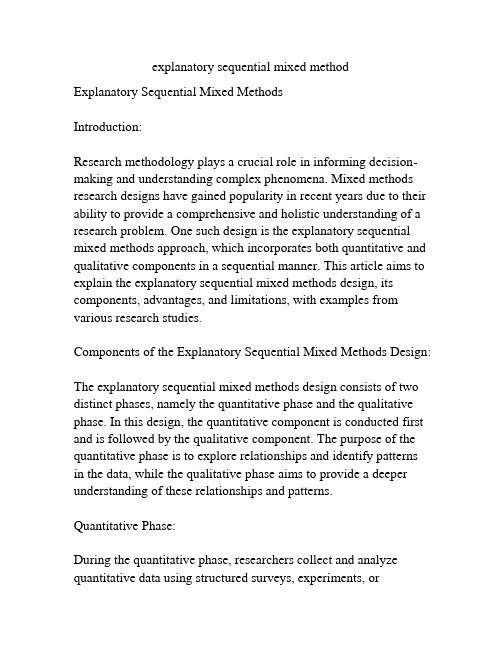
explanatory sequential mixed method Explanatory Sequential Mixed MethodsIntroduction:Research methodology plays a crucial role in informing decision-making and understanding complex phenomena. Mixed methods research designs have gained popularity in recent years due to their ability to provide a comprehensive and holistic understanding of a research problem. One such design is the explanatory sequential mixed methods approach, which incorporates both quantitative and qualitative components in a sequential manner. This article aims to explain the explanatory sequential mixed methods design, its components, advantages, and limitations, with examples from various research studies.Components of the Explanatory Sequential Mixed Methods Design:The explanatory sequential mixed methods design consists of two distinct phases, namely the quantitative phase and the qualitative phase. In this design, the quantitative component is conducted first and is followed by the qualitative component. The purpose of the quantitative phase is to explore relationships and identify patterns in the data, while the qualitative phase aims to provide a deeper understanding of these relationships and patterns.Quantitative Phase:During the quantitative phase, researchers collect and analyze quantitative data using structured surveys, experiments, orsecondary data sources. The goal is to generate numerical data that can be analyzed using statistical techniques to test hypotheses or patterns. The findings from the quantitative analysis inform the selection of participants and the focus of the qualitative phase.Qualitative Phase:The qualitative phase involves collecting and analyzing qualitative data, such as interviews, observations, or document analysis. The purpose of this phase is to understand the underlying reasons and processes behind the quantitative findings. Qualitative data collection methods allow researchers to gather rich and detailed information that provides context and meaning to the statistical results. The qualitative analysis involves coding, categorizing, and interpreting the data to identify themes and patterns.Integration of Findings:The integration of findings is a crucial step in the explanatory sequential mixed methods design. During this stage, researchers compare and contrast the findings from both the quantitative and qualitative phases to develop a comprehensive understanding of the research problem. This integration can occur in different ways, such as comparing the results side by side, using statistical findings to interpret qualitative data, or using qualitative findings to explain statistical patterns. The aim is to provide a richer and more nuanced understanding of the research topic than could be achieved through a single method or phase.Advantages of the Explanatory Sequential Mixed Methods Design:The explanatory sequential mixed methods design offers several advantages over traditional quantitative or qualitative approaches. Firstly, it provides a more comprehensive understanding of the research problem by combining quantitative and qualitative data. The sequential nature of the design allows researchers to build on the findings from the quantitative phase and explore them in more depth during the qualitative phase. This approach strengthens the validity and reliability of the research findings.Secondly, the design allows researchers to address research questions that require both numerical data and contextual information. Some phenomena cannot be fully understood or explained by numbers alone, and qualitative data can provide valuable insights into the underlying reasons and processes.Thirdly, the design enhances triangulation, which refers to the use of multiple data sources or methods to validate findings. By combining quantitative and qualitative data, researchers can compare and contrast the different perspectives and identify converging or conflicting evidence. This strengthens the overall validity and trustworthiness of the research.Limitations of the Explanatory Sequential Mixed Methods Design:Despite its advantages, the explanatory sequential mixed methods design also has some limitations. Firstly, it requires time and resources to implement both quantitative and qualitative components. Researchers need to consider the feasibility of conducting both phases and ensure that they have the necessaryskills and expertise in both quantitative and qualitative methods.Secondly, the design may face challenges in terms of data integration and interpretation. Combining quantitative and qualitative findings can be complex and may require expertise in both types of data analysis. Researchers need to carefully consider how to integrate the findings in a meaningful and coherent manner.Example Studies:To illustrate the application of the explanatory sequential mixed methods design, three example studies are presented below:1. A study on the effectiveness of a health intervention program uses a quantitative survey to measure participants' health outcomes and satisfaction levels. The qualitative phase involves in-depth interviews with a sub-sample of participants to explore their experiences and perceptions of the program.2. A study on the impact of a teacher training program uses a quantitative pre-test and post-test design to measure changes in students' academic performance. The qualitative phase involves focus group discussions with teachers to understand their perspectives on the program's effectiveness and challenges.3. A study on the factors influencing employee satisfaction and retention uses a quantitative survey to measure employee satisfaction levels. The qualitative phase involves semi-structured interviews with a subset of employees to explore the underlying reasons for their satisfaction or dissatisfaction.Conclusion:The explanatory sequential mixed methods design offers a powerful approach to research that combines the strengths of quantitative and qualitative methods. By integrating numerical data with contextual information, this design provides a comprehensive and holistic understanding of research problems. Despite its limitations, the design has gained popularity due to its ability to address complex research questions and enhance the validity and reliability of findings. Researchers should consider the feasibility and appropriateness of this design for their specific research objectives and resources.。
混合效应英语

混合效应英语Mixed Effects EnglishThe world of language is a complex and multifaceted one, where the interplay of various factors can give rise to fascinating phenomena. One such phenomenon is the concept of "mixed effects," which refers to the blending of linguistic elements from different sources or backgrounds. In the realm of English, this concept has become increasingly relevant, as the language continues to evolve and adapt to the ever-changing global landscape.At the heart of mixed effects English lies the notion of linguistic diversity. As the world becomes more interconnected, the exchange of ideas, cultures, and traditions has led to a rich tapestry of linguistic influences. English, in particular, has been at the forefront of this linguistic melting pot, absorbing and incorporating elements from a wide range of languages and dialects.One of the most prominent examples of mixed effects English can be found in the realm of vocabulary. The English language has a long and storied history, with roots tracing back to the Germanic tribes that settled in Britain centuries ago. Over time, however, English hasbeen enriched by the influx of words and expressions from other languages, such as French, Latin, Greek, and even indigenous languages from around the world.This linguistic cross-pollination has resulted in a remarkably diverse lexicon, where words from different origins coexist and often blend seamlessly. For instance, the word "restaurant" is derived from the French language, while "algebra" has its roots in Arabic. Yet, both of these words have become integral parts of the English vocabulary, seamlessly integrated into the language.Moreover, the influence of mixed effects can be observed in the evolution of English grammar and syntax. As the language has spread across the globe, it has adapted to the linguistic structures and conventions of the regions it has encountered. This has led to the emergence of regional variations and dialects, each with its own unique grammatical patterns and idiomatic expressions.For example, the use of "y'all" in certain parts of the United States, or the inclusion of specific grammatical structures in Indian English, are reflections of the mixed effects that have shaped the language. These variations, rather than being seen as deviations from a "pure" form of English, should be celebrated as the natural consequences of the language's adaptability and resilience.Beyond the realms of vocabulary and grammar, mixed effects English can also be observed in the realm of pronunciation and accent. As English has spread across the globe, it has been influenced by the phonological systems of the local languages. This has resulted in a rich tapestry of accents, each with its own unique characteristics and nuances.From the melodic tones of Indian English to the distinctive rhythms of Caribbean English, these accents are not merely variations but rather expressions of the cultural and linguistic diversity that has shaped the language. They serve as a testament to the adaptability and resilience of English, as it continues to evolve and thrive in diverse contexts.The phenomenon of mixed effects English is not limited to the linguistic realm alone. It also has profound social and cultural implications. As the language has become a global lingua franca, it has facilitated cross-cultural communication and exchange, enabling individuals from diverse backgrounds to connect and share ideas.In this context, mixed effects English has become a powerful tool for cultural expression and identity. Individuals and communities have embraced the language, infusing it with their own cultural elements and creating unique forms of expression. This has led to the emergence of vibrant literary traditions, music, and art that blend thelinguistic and cultural influences of different regions.Moreover, the recognition and acceptance of mixed effects English have important implications for language education and policy. Rather than insisting on a singular, "correct" form of English, educators and policymakers should embrace the diversity of the language and encourage students to develop their linguistic skills in a way that reflects their cultural and regional identities.By doing so, they can foster a more inclusive and equitable language learning environment, where students are empowered to express themselves authentically and confidently, regardless of their linguistic background.In conclusion, the phenomenon of mixed effects English is a testament to the inherent dynamism and adaptability of language. As the world becomes increasingly interconnected, the blending of linguistic elements from diverse sources has become an integral part of the evolution of English. This process has enriched the language, fostered cross-cultural communication, and challenged traditional notions of linguistic purity.By embracing the diversity and complexity of mixed effects English, we can gain a deeper appreciation for the power of language to reflect and shape the human experience. It is a testament to theresilience and creativity of the human spirit, as we continue to navigate the ever-changing landscape of global communication and cultural exchange.。
生理学——细胞的功能
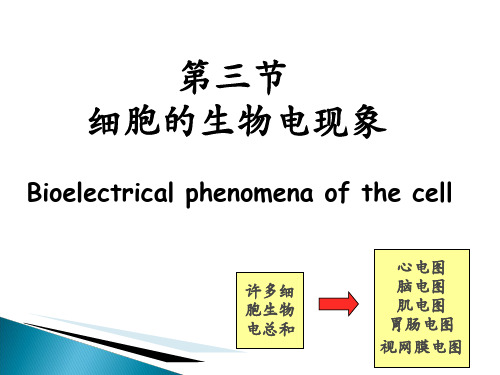
三、静息电位
静息时,质膜两侧存在着外正内负的电位 差,称为静息电位<resting potential, RP>.
Relative constant potential difference
1939年,英国 Hodgkin & Huxley 记录枪乌鲗巨大神经轴突的RP
静息电位时膜两侧所保持的外正内负状态称为 膜的极化<polarization>;
静息电位并不完全等于EK
ECl: -70 - -90 mv, RP并不取决于ECl Cl-在膜两侧的分布是被动的, 膜电位的大小可以决定 Cl-在膜内的浓度
3. 钠泵的生电作用:
影响静息电位增大〔超极化〕
影响RP的因素:
〔1〕细胞外K+的浓度:
K+ 轻度 EK 的负值 RP 〔去极
化〔〕2〕离子通透性:
膜蛋白 = 导体
对带电离子而言,膜电导就是膜对离子的通透性 <permeability>.
3. 轴向电阻 取决于胞质溶液本身的电阻/细胞直径
•一点给予膜一个突 然的电流,从另一点 记录膜电位变化:
•①在电流注入处达 到的电位最大;
•②离开电流注入处 越远,膜电位越小;
• ③电位依距离变小, 是膜电阻及轴向电阻 引起的后果.
假定静息电位Em = -70mV,ENa = +60mV,EK = -90mV:
Na+驱动力: Em- ENa=-70mV-<+60mV>=-130mV K+驱动力: Em- EK=-70mV-<-90mV>=+20mV
〔2〕离子的通透性 <膜电导的变化〕
测定公式
分子生物学词汇(Q-R)_生物化学英语词汇

quadriplex 四显性组合quadrivalent 四价的;四价体quadruplex 四显性组合quadruplex dna 四元dnaquartering 四分(法)quasidominance 准显性quasispecies 准种[由一种母序列和来自该序列的大量相关突变体所组成的病毒基因组]quasisymmetry 准对称quassin 苦木素quaternary 四级的;四元的;季quick stop mutation 快停突变[大肠杆菌中升温至42℃即停止复制的突变]quinacrine 喹吖因quinhydrone 醌氢醌quinidine 奎尼定[抗心律不齐药]quinochrome 醌色素quinoline 喹啉quinolizidine 喹嗪quinomycin 醌霉素quinone 醌quinoprotein 醌蛋白[以吡咯并喹啉醌为辅基]quinuclidinyl 奎宁环基rabbit hemorrhagic disease virus 兔出血病病毒[属杯状病毒科] rabbitpox virus 兔痘病毒rabies virus 狂犬病毒rabphilin rab亲和蛋白[rab蛋白是指ras相关gtp结合蛋白]raccoonpox virus 浣熊痘病毒racemase 消旋酶racemate 外消旋物racemic 外消旋的racemization 外消旋化raddicle 胚根radicin 根蛋白radioelectrophoresis 放射电泳radiograph 放射显影图,射线照相radiography 放射显影(法)radioimmunoassay 放射免疫测定,放射免疫分析radioimmunoelectrophoresis 放射免疫电泳radioimmunoimaging 放射免疫成像radioimmunology 放射免疫学radioimmunoprecipitation 放射免疫沉淀(法)radioiodinated 放射性碘化的radioiodination 放射性碘化radiolabeled 放射性标记的radiolabeling 放射性标记radioligand 放射性配体radiolysis 辐(射分)解(作用)radiometer 放射计,辐射计radionuclide 放射性核素radiopaque 不透射线的radioparent (可)透射线的radiophotoluminescence 放射光致发光radioprotectant 辐射防护剂radiosensitivity 辐射敏感性radiosensitization 辐射敏化radiosensitizer 辐射敏化剂radixin 根蛋白[可作用于肌动蛋白丝] radwaste 放射性废物raffinose 棉子糖ragweed 豚草raji cell raji细胞ramachandran map ramachandran图,拉氏图[指示蛋白质主链二面角允许值范围的图形]ranatensin 蛙(紧张)肽,豹蛙(紧张)肽rapamycin 纳巴霉素,雷帕霉素raphe 缝际;种脊rauwolscine 萝芙素reading frame 读框,阅读框架reagin 反应素reannealing 重退火reassociation 重缔合reassortment 重配rebound 回跳[用于神经系统]recognin 识别子,识别蛋白recombinant 重组子,重组体,重组的recombinase 重组酶recombulin [商]重组胰岛素[gibco公司商标]recon 重组子recoverin 恢复蛋白[见于脊椎动物视网膜的钙传感蛋白,可促进cgmp的重合成、钙通道的重开放及暗状态的恢复]red drop 红降red shift 红移reduced viscosity 比浓粘度regulon 调节子[受控于同一调节蛋白的多个操纵子]remnant 残迹[如用于描述分子进化]renin 肾素rennin 凝乳酶reovirus 呼肠(孤)病毒repeating dispenser 重复分液器[带有贮液装置并可连续反复多次放出液体的分液器]replicase 复制酶replicative eys 复制眼[长段非复制序列中的dna复制区]replicative recombination 复制重组[通过可动遗传因子从基因的一个位置复制到另一个位置]replicator 复制因子,复制基因replicon 复制子replisome 复制体[执行dna复制功能的多种蛋白质复合体]repolarization 复极化reporter 报道基因,报道分子reporter gene 报道基因,报告基因[处于另一基因下游并可反映转录及上游基因表达水平的基因]reporter molecule 报道分子[具有类似指示剂作用的分子]representation 表现度repression 阻抑,阻遏repressor 阻抑物,阻遏物,阻抑蛋白reptilia 爬行纲[节肢动物]resact 呼吸活化肽[一种海胆卵肽,可刺激精子的呼吸]reserpine 利血平resilin 节肢弹性蛋白resolvase 解离酶resorufin 试卤灵,9-羟基-3-异吩恶唑酮respirometer 呼吸计resting cell 静息细胞[具有生命代谢能力而处于停止分裂状态的细胞]restitope (依)托位[抗原呈递中,t细胞受体上与ⅱ类组织相容性复合体分子相互作用的部位]restorer 恢复系restorpin 网状内皮(作用)素restricted transduction 局限转导[在细菌细胞生活周期中易于接受外源dna的某种暂时状态下出现]retardin 阻滞素,延缓素reticulin 网硬蛋白;网硬素reticulocyte 网织红细胞reticuloendothelial system 网状内皮系统retina 视网膜retinal 视黄醛;视网膜的retinaldehyde 视黄醛retinene 视黄醛retinoblastoma 成视网膜细胞瘤的,rb的retinol 视黄醇retriever vector 挽回载体[携有野生型基因侧翼序列并可用于克隆相应突变基因的穿梭载体]retroegulation 反向调节[下游序列对翻译的调节]retroelement 逆转录因子retronphage 逆转录子噬菌体retroposon 逆转录子retropseudogene 逆转录假基因[关于假基因起源的一种假说]retrosynthesis 逆合成[从相反方向分析合成路线]retrotransposition 逆转录转座(作用)retrotransposon 逆转录转座子[转座过程中出现逆转录,如酵母tyl和果蝇copia]retrovir [商]叠氮胸苷retroviral vector 逆转录病毒载体retrovirus 逆转录病毒,反(转)录病毒reuptake 重摄取revaccination 疫苗再接种reverberation 回荡[用于神经系统]reverse band r带,(相)反带[与q带相反的带]reverse biochemistry 反向生物化学[通过克隆化基因的表达产物反过来研究体内蛋白质的生化特性]reversion 回复突变revertant 回复体revistin 制逆转录酶素rf value rf值,比移值rhabdovirus 弹状病毒rhamnose 鼠李糖rheogram 流变图rheology 流变学rhinovirus 鼻病毒rhizobia 根瘤菌rhizocaline 成根素rhizome 根(状)茎rhizomorph 菌索[见于真菌]rhizopin 根霉促进素rhizoplast 根丝体rhizopterin 根霉蝶呤rhizosphere 根际rhizospheric 根际的rhodamine 罗丹明rhodanese 硫氰酸酶rhodomorphin 红形素rhodophyta 红藻门rhodoplast 藻红体rhodopseudomonacin 红假单胞菌素rhodopsin 视紫红质,视紫质,紫红质,紫膜质rhodospirillum 红螺菌属rhodotoxin 玫红毒素,杜鹃花毒素ri plasmid ri质粒,毛根诱导质粒ribavirin 三氮唑核苷,病毒唑riboflavin 核黄素ribohomopolymer 核糖核酸同聚体ribolose 核酮糖ribonuclease 核糖核酸酶,rna酶ribonucleoprotein 核糖核蛋白ribophorin 核糖体结合(糖)蛋白,核糖体受体蛋白[见于糙面内质网]ribopolymer 核糖核酸多聚体ribose 核糖ribosomal 核糖体的ribosome 核糖体ribostamycin 核糖霉素ribosyl 核糖基ribosylation 核糖基化(作用)ribovirin 病毒唑ribozyme 核酶[可切割特异性rna序列的rna分子]ricin 蓖麻毒蛋白rickettsia 立克次氏体rickettsia burneti 伯氏q热立克次氏体rickettsia typhi 斑疹伤寒立克次氏体rider 游码rifampicin 利福平rifampin 利福平rifamycin 利福霉素rimocidin 龟裂杀菌素ristocetin 瑞斯托菌素ristomycin 瑞斯托霉素rna editing rna编辑[在初级转录物上增删或取代某些核苷酸而改变遗传信息]rna ladder rna梯[如大小不同的rna分子量标准参照物的电泳谱]rna transport rna转运[主要指rna从细胞核转运到细胞质]rnasin [商]rna酶蛋白质抑制剂[promega公司商标]robertsonian translocation 罗伯逊易位[非同源染色体端着丝粒之间融合,或两个近端着丝粒染色体相互易位而形成一个染色体] rod 杆菌;(视)杆细胞rosamicin 蔷薇霉素rosette (玫瑰)花结rotamase 旋转异构酶rotamer 旋转异构体rotavirus 轮状病毒rotenoid 鱼藤酮(类)生物碱rotenono 鱼藤酮rous sarcoma virus rous肉瘤病毒rubella virus 风疹病毒rubidomycin 红比霉素rubisco 核酮糖二磷酸羧化酶-加氧酶rubredoxin 玉红氧还蛋白[一种不含血红素的铁蛋白]ruffling [细胞]边缘波动ruminant 反刍动物;反刍(动物)的rutin 芸香苷,芦丁rutoside 芸香苷。
名词委审定 汉英化学工程名词
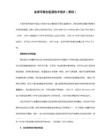
又称“有效能衡算”。
○分析 exergy analysis, availability analysis
又称“有效能分析”。
热经济学 thermo-economics
卡诺循环 Carnot cycle
兰金循环 Rankine cycle
压缩制冷 compression refrigeration
热力学第三定律 third law of thermodynamics
能量守恒定律 law of conservation of energy
热力学函数 thermodynamic function
热力学平衡 thermodynamic equilibrium
热力学温度 thermodynamc temperature 冷模试验 cold-flow model experiment, mockup experiment
用空气、水、砂等模拟真实物料所进行的试验。
台架试验 bench scale test
又称“模型试验”。
中间试验装置 pilot plant
简称“中试装置”。
原型试验 prototype experiment
马赫数 Mach number
努塞特数 Nusselt number
佩克莱数 Peclet number
普朗特数 Prandtl number
瑞利数 Rayleigh number
雷诺数 Reynolds number
施密特数 Schmidt number
舍伍德数 Sherwood number
曾用名“克-克方程”。
克劳修斯不等式 Clausius inequality
扩散系数 英语

扩散系数英语Diffusion CoefficientThe concept of diffusion coefficient is a fundamental principle in various scientific fields, including physics, chemistry, and biology. It represents the measure of the rate at which particles or molecules move through a medium due to the random thermal motion, also known as Brownian motion. This coefficient plays a crucial role in understanding and predicting the behavior of various physical and chemical processes, from the transport of nutrients in living organisms to the dispersion of pollutants in the environment.The diffusion coefficient, denoted by the symbol D, is a quantitative measure of the ability of a substance to diffuse or spread out within a medium. It is typically expressed in units of square meters perse cond (m²/s) or square centimeters per second (cm²/s). The value of the diffusion coefficient depends on several factors, such as the size and shape of the diffusing particles, the temperature of the system, and the viscosity of the medium.One of the most well-known laws governing diffusion is Fick's first law, which states that the flux of a substance, or the amount of thesubstance passing through a unit area per unit time, is proportional to the concentration gradient of the substance. This law can be expressed mathematically as:J = -D × (∂C/∂x)where J is the flux, D is the diffusion coefficient, and ∂C/∂x is the concentration gradient of the substance in the direction of diffusion.The negative sign in the equation indicates that the direction of the flux is from the region of higher concentration to the region of lower concentration, as diffusion naturally occurs to equalize the concentration differences.The diffusion coefficient can be influenced by various factors, including temperature, pressure, and the properties of the diffusing substance and the medium. For example, in gases, the diffusion coefficient is inversely proportional to the square root of the molecular weight of the diffusing substance, as described by the Graham's law of diffusion. In liquids, the diffusion coefficient is generally smaller than in gases and is affected by the viscosity of the medium.One important application of the diffusion coefficient is in the study of transport phenomena in living organisms. In biological systems,the diffusion of molecules, such as oxygen, nutrients, and signaling molecules, plays a crucial role in various physiological processes. The diffusion coefficient of these molecules can be measured experimentally or estimated using theoretical models, allowing researchers to understand and predict the movement and distribution of these substances within the body.Another important application of the diffusion coefficient is in the field of materials science, where it is used to study the transport of atoms, ions, or defects within solid materials. This information is crucial for understanding and controlling the properties of materials, such as their strength, electrical conductivity, and corrosion resistance.In the field of environmental science, the diffusion coefficient is used to model the transport and dispersion of pollutants in air, water, and soil. By understanding the diffusion behavior of these pollutants, scientists can develop strategies for mitigating their environmental impact and predicting their fate in the ecosystem.The study of diffusion coefficients has also found applications in various other fields, such as chemical engineering, where it is used to design and optimize processes involving mass transfer, and in the development of drug delivery systems, where the diffusion of drugs through biological membranes is a critical factor.In conclusion, the diffusion coefficient is a fundamental concept that underpins our understanding of a wide range of physical, chemical, and biological phenomena. Its accurate measurement and modeling are essential for advancing scientific knowledge and developing practical applications in various industries and research areas. As our understanding of diffusion processes continues to evolve, the diffusion coefficient will remain a crucial tool for exploring and understanding the complex world around us.。
血管瘤课件精品文档

Clinical Features/Natural History
proliferative phase
Within weeks to months of birth, the proliferative phases ensue and the hemangioma becomes evident. Growth is most rapid in the first 3–6 months, and maximal size is obtained by 9–12 months of a
Epidemiology
Neonates 1-year-old infants Present in all races female predominance Prematurity low birth weight Inheritance
1 –2% 10 –12% Caucasians↑ 2:1 to 5:1
Congenital Malformations
Summary
A classification system was proposed by Mulliken and Glowacki and modified by the International Society for the Study of Vascular Anomalies in 2019 to help clarify this confusion.
Clinical Features/Natural History
head and neck (60%)
trunk
(25%)
extremities (15%).
Deep hemangiomas “cavernous hemangiomas,”
气液两相等 英语

Gas-Liquid EquilibriumGas-liquid equilibrium is a fundamental concept in chemical engineering and plays a crucial role in various industrial processes. It refers to the state where the rate of evaporation of a liquid is equal to the rate of condensation of its vapor in a closed system at a specific temperature and pressure.At equilibrium, the concentration of the vapor and liquid phases remains constant, and the system is said to be in a steady state. The equilibrium conditions depend on the nature of the liquid and the gas, as well as the temperature and pressure of the system.The equilibrium between a gas and a liquid is governed by the laws of thermodynamics, particularly the Gibbs free energy. The change in Gibbs free energy determines the direction of the reaction, with the reaction proceeding in the direction that minimizes the free energy.The equilibrium conditions can be determined experimentally by measuring the vapor pressure of the liquid at various temperatures. The vapor pressure is the pressure exerted by the vapor when it is in equilibrium with the liquid at a specific temperature. The relationship between the vapor pressure and temperature is described by the Clausius-Clapeyron equation.In addition to the vapor pressure, the equilibrium conditions can also be determined by the Henry's law constant. Henry's law relates the concentration of a gas in a liquid to the partial pressure of the gas above the liquid. The constant depends on the nature of the gas and the liquid and can be determined experimentally.In conclusion, gas-liquid equilibrium is a critical concept in chemical engineering and is essential in various industrial processes. The equilibrium conditions can be determined experimentally, and the Gibbs free energy and Henry's law constant play crucial roles in determining the equilibrium state. Understanding gas-liquid equilibrium is crucial to the design and optimization of chemical processes.。
0Xmevy医学生理学名词解释
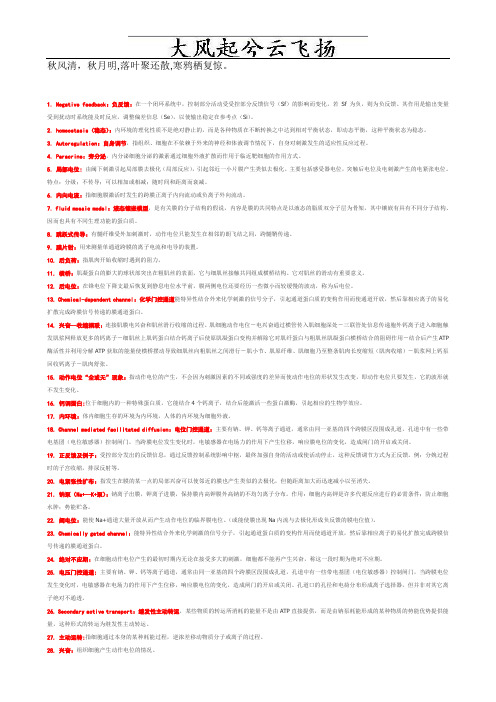
秋风清,秋月明,落叶聚还散,寒鸦栖复惊。
1. Negative feedback:负反馈:在一个闭环系统中,控制部分活动受受控部分反馈信号(Sf)的影响而变化,若Sf为负,则为负反馈。
其作用是输出变量受到扰动时系统能及时反应,调整偏差信息(Se),以使输出稳定在参考点(Si)。
2. homeostasis(稳态):内环境的理化性质不是绝对静止的,而是各种物质在不断转换之中达到相对平衡状态,即动态平衡,这种平衡状态为稳态。
3. Autoregulation:自身调节,指组织、细胞在不依赖于外来的神经和体液调节情况下,自身对刺激发生的适应性反应过程。
4. Paracrine:旁分泌,内分泌细胞分泌的激素通过细胞外液扩散而作用于临近靶细胞的作用方式。
5. 局部电位:由阈下刺激引起局部膜去极化(局部反应),引起邻近一小片膜产生类似去极化。
主要包括感受器电位,突触后电位及电刺激产生的电紧张电位。
特点:分级;不传导;可以相加或相减;随时间和距离而衰减。
6. 内向电流:指细胞膜激活时发生的跨膜正离子内向流动或负离子外向流动。
7. fluid mosaic model:液态镶嵌模型,是有关膜的分子结构的假说,内容是膜的共同特点是以液态的脂质双分子层为骨架,其中镶嵌有具有不同分子结构、因而也具有不同生理功能的蛋白质。
8. 跳跃式传导:有髓纤维受外加刺激时,动作电位只能发生在相邻的朗飞结之间,跨髓鞘传递。
9. 膜片钳:用来测量单通道跨膜的离子电流和电导的装置。
10. 后负荷:指肌肉开始收缩时遇到的阻力。
11. 横桥:肌凝蛋白的膨大的球状部突出在粗肌丝的表面,它与细肌丝接触共同组成横桥结构。
它对肌丝的滑动有重要意义。
12. 后电位:在锋电位下降支最后恢复到静息电位水平前,膜两侧电位还要经历一些微小而较缓慢的波动,称为后电位。
13. Chemical-dependent channel:化学门控通道能特异性结合外来化学刺激的信号分子,引起通道蛋白质的变构作用而使通道开放,然后靠相应离子的易化扩散完成跨膜信号传递的膜通道蛋白。
【清华】生化名词解释
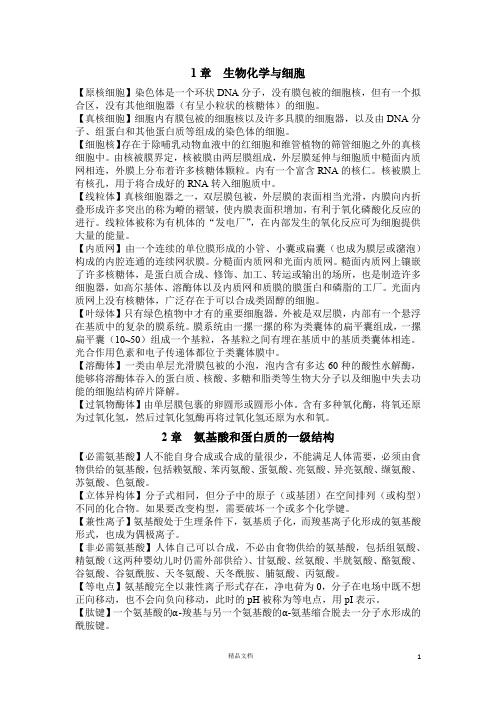
1章生物化学与细胞【原核细胞】染色体是一个环状DNA分子,没有膜包被的细胞核,但有一个拟合区,没有其他细胞器(有呈小粒状的核糖体)的细胞。
【真核细胞】细胞内有膜包被的细胞核以及许多具膜的细胞器,以及由DNA分子、组蛋白和其他蛋白质等组成的染色体的细胞。
【细胞核】存在于除哺乳动物血液中的红细胞和维管植物的筛管细胞之外的真核细胞中。
由核被膜界定,核被膜由两层膜组成,外层膜延伸与细胞质中糙面内质网相连,外膜上分布着许多核糖体颗粒。
内有一个富含RNA的核仁。
核被膜上有核孔,用于将合成好的RNA转入细胞质中。
【线粒体】真核细胞器之一,双层膜包被,外层膜的表面相当光滑,内膜向内折叠形成许多突出的称为嵴的褶皱,使内膜表面积增加,有利于氧化磷酸化反应的进行。
线粒体被称为有机体的“发电厂”,在内部发生的氧化反应可为细胞提供大量的能量。
【内质网】由一个连续的单位膜形成的小管、小囊或扁囊(也成为膜层或潴泡)构成的内腔连通的连续网状膜。
分糙面内质网和光面内质网。
糙面内质网上镶嵌了许多核糖体,是蛋白质合成、修饰、加工、转运或输出的场所,也是制造许多细胞器,如高尔基体、溶酶体以及内质网和质膜的膜蛋白和磷脂的工厂。
光面内质网上没有核糖体,广泛存在于可以合成类固醇的细胞。
【叶绿体】只有绿色植物中才有的重要细胞器。
外被是双层膜,内部有一个悬浮在基质中的复杂的膜系统。
膜系统由一摞一摞的称为类囊体的扁平囊组成,一摞扁平囊(10~50)组成一个基粒,各基粒之间有埋在基质中的基质类囊体相连。
光合作用色素和电子传递体都位于类囊体膜中。
【溶酶体】一类由单层光滑膜包被的小泡,泡内含有多达60种的酸性水解酶,能够将溶酶体吞入的蛋白质、核酸、多糖和脂类等生物大分子以及细胞中失去功能的细胞结构碎片降解。
【过氧物酶体】由单层膜包裹的卵圆形或圆形小体。
含有多种氧化酶,将氧还原为过氧化氢,然后过氧化氢酶再将过氧化氢还原为水和氧。
2章氨基酸和蛋白质的一级结构【必需氨基酸】人不能自身合成或合成的量很少,不能满足人体需要,必须由食物供给的氨基酸,包括赖氨酸、苯丙氨酸、蛋氨酸、亮氨酸、异亮氨酸、缬氨酸、苏氨酸、色氨酸。
溶液-10(非理性溶液各组分的化学势)

1. 非理想稀溶液2. 溶剂的活度3. 溶质的活度非理想稀溶液什么是非理想稀溶液?溶剂对Raoult 定律发生偏差,溶质对Henry 定律发生偏差,这种偏差可正可负。
这种稀溶液偏离了理想状态,称为非理想稀溶液。
非理想稀溶液的浓度和化学势由于发生了偏差,使溶剂或溶质的实测蒸气压与计算值不符,这同样影响了化学势的值。
因而Lewis 引进了相对活度的概念。
溶剂的活度在理想稀溶液中Raoult 定律为对于非理想稀溶液,Raoult 定律修正为AA *A p x p =A,A A *Ax p x p γ=,A ,A Ax x a x γ=令则,A ,AAx x a x γ=,A,AAlim lim 1x x a x γ==A 1x →A1x →,Ax a 称为用摩尔分数表示的溶剂的相对活度,Ax γ简称活度,单位为1称为用摩尔分数表示的溶剂的活度因子单位为1非理想稀溶液中,溶剂化学势表达式修正为A A ,A(,)()ln x T p T RT a μμ=+,A,AAlim lim 1x x a x γ==A 1x →A1x →溶剂的活度溶质的活度在理想稀溶液中Henry 定律为对于非理想稀溶液,Henry 定律修正为B ,B B x p k x =,B ,B Bx x a x γ=令则B ,B ,B Bx x p k x γ=B ,B ,Bx x p k a =*B B,B(,)(,)ln x T p T p RT a μμ=+对应化学势的表示式为当溶液很稀,B 1x γ→,B Bx a x ≈在理想稀溶液中当Henry 定律为对于非理想稀溶液,Henry 定律修正为B ,B B m p k m =,B B,Bm m m a mγ=令B ,B ,B B m m p k m γ=对应化学势的表示式为B ,B Bc p k c =B ,B ,B Bc c p k c γ=B,B,Bc c c a cγ=B B ,B(,)(,)ln m T p T p RT a μμ=+□B B,B(,)(,)ln c T p T p RT a μμ=+Δ溶质的活度因为B ,B (,)ln m T p RT a μ=+□B ,B(,)ln c T p RT a μ∆=+*B B,B(,)(,)ln x T p T p RT a μμ=+,B ,B ,Bx m c a a a ≠≠所以*BBB(,)(,)(,)T p T p T p μμμ∆≠≠□但溶质的化学势只有一个数值溶质的活度。
- 1、下载文档前请自行甄别文档内容的完整性,平台不提供额外的编辑、内容补充、找答案等附加服务。
- 2、"仅部分预览"的文档,不可在线预览部分如存在完整性等问题,可反馈申请退款(可完整预览的文档不适用该条件!)。
- 3、如文档侵犯您的权益,请联系客服反馈,我们会尽快为您处理(人工客服工作时间:9:00-18:30)。
Sometimes they contain solubilized water in excess of certain amount and known as w/o microemulsions [1–5]. RMs or w/o microemulsions find applications starting from tertiary oil recovery to nanoparticle synthesis [1,6–10]. Reverse micelles possess highly dynamic structures whose components rearrange themselves over time and space through interactions or collisions, coalescing and redispersing. The structure and properties of reverse micellar systems have been investigated extensively by numerous methods [2,3, 6–10]. Of these, the measurement of conductivity is a useful technique in obtaining information on micellar interactions [6,11,12].
Abstract The conductivity of AOT/IPM/water reverse micellar systems as a function of temperature, has been found to be non-percolating at three different concentrations (100, 175 and 250 mM), while the addition of nonionic surfactants [polyoxyethylene(10) cetyl ether (Brij-56) and polyoxyethylene(20) cetyl ether (Brij-58)] to these systems exhibits temperature-induced percolation in conductance in non-percolating AOT/isopropyl myristate (IPM)/water system at constant compositions (i.e., at fixed total surfactant concentration, ω and Xnonionic ). The influence of total surfactant concentration (micellar concentration) on the temperature-induced percolation behaviors of these systems has been investigated. The effect of Brij-58 is more pronounced than that of Brij-56 in inducing percolation. The threshold percolation temperature, Tp has been determined for these systems in presence of additives of different molecular structures, physical parameters and/or interfacial properties. The additives have shown both assisting and resisting effects on the percolation threshold. The additives, bile salt (sodium cholate), urea, formamide, cholesteryl acetate, cholesteryl benzoate, toluene, a triblock copolymer [(EO)13 (PO)30 (EO)13 , Pluronic, PL64], polybutadiene, sucrose esters (sucrose dodecanoates, L-1695 and sucrose monostearate S-1670), formamide distinctively fall in the former category, whereas sodium chloride, cholesteryl palmitate, crown ether, ethylene glycol constitute the latter for both systems. Sucrose dodecanoates (L-595) had almost marginal effect on the process. The observed behavior of these additives on the percolation phenomenon has been explained in terms of critical packing parameter and/or other factors, which influence the texture of the interface and solution properties of the mixed reverse micellar systems. The activation energy, Ep for the percolation process has been evaluated. Ep values for the AOT/Brij-56 systems have been found to be lower than those of AOT/Brij-58 systems. The concentration of additives influence the parameters Tp and Ep for both systems. A preliminary report for the first time on the percolation phenomenon in mixed reverse micelles in presence of additives has been suggested on the basis of these parameters (Tp and Ep ). 2005 Elsevier Inc. All rights reserved.
* Correspห้องสมุดไป่ตู้nding author.
E-mail address: bidyut@isical.ac.in (B.K. Paul). 0021-9797/$ – see front matter 2005 Elsevier Inc. All rights reserved. doi:10.1016/j.jcis.2005.07.072
Journal of Colloid and Interface Science 295 (2006) 230–242 /locate/jcis
Percolation phenomenon in mixed reverse micelles: The effect of additives
B.K. Paul, R.K. Mitra / Journal of Colloid and Interface Science 295 (2006) 230–242
231
The phenomenon of electrical percolation is characterized by sudden increase in electrical conductivity when either the temperature or the volume fraction of the dispersed phase reaches a certain threshold value. The nature and the basic understanding of the percolation process have been investigated by a number of research workers [13–17]. The enhanced conductance has been considered to take place by the formation of infinite clusters/association of dispersed water droplets (stabilized by the amphiphiles) in the oil continuous medium. The easy flow of charges (ions) takes place by “hopping” [18–21] from droplet to droplet or are transferred by way of “fusion, mass transfer and mass exchange” [22–25]. As a consequence of the ion transfer, the conductance can be enhanced by 100 to 1000 folds. The composition of the system and other environmental conditions such as the presence of additives controls the percolation threshold values [26–30]. AOT can form reverse micelles under wide range of conditions (such as, water content, temperature, solvent, electrolyte type and concentrations) without the need of cosurfactant [31]. Over the past decade a number of studies have been carried out on the effects of various kinds of additives on the electrical conductivity and other properties of water/AOT/hydrocarbon oils reverse micelles by several researchers [25,27,32–43]. The percolation phenomenon has been shown to occur earlier (assistance) or be delayed (retardation) in presence of additives; however, many of them remained totally ineffective. The “transient-fusionmass transfer-fission” model has been found to be more applicable over the “hopping” model in most of the cases to explain the percolation phenomenon. Of these studies, the work of Moulik et al. [25,27,32–36], Garcia-Rio et al. [38–40] are noteworthy. Above reports concern mainly the percolation of conductance in water/AOT/hydrocarbon w/o microemulsions. Investigations on the microstructures and properties of reverse micelles formed with mixed surfactants (i.e., addition of a second surfactant to water/single surfactant/oil system) has seldom been carried out to understand the basic mechanism of the phenomenon taking place inside them. However, reports available on the latter aspect are due to Alexandradis et al. [28], Nazario et al. [44], Eicke et al. [45,46], Li et al. [47,48], Liu et al. [49,50], Bumajdad et al. [51]. In our previous studies, the solubilization behavior of water in anionic (AOT) or cationic didodecyldimethylammonium bromide (DDAB)/nonionic surfactants (of different chemical structures and physicochemical properties) mixed reverse micellar systems stabilized in isopropyl myristate, isobutyl benzene and cyclohexane at different temperatures has been reported [12,52]. In a subsequent study [6], the effects of water content (ω), micelle concentrations, content of nonionic surfactant of different types (Brijs, Spans, Tweens) on the temperature-induced percolation of conductance of AOT-nonionics and DDAB-nonionics [polyoxyethylene(10) cetyl ether (Brij-56) and polyoxyethylene(20) cetyl ether (Brij-58) only] mixed reverse micelles in a nontoxic oil IPM,
